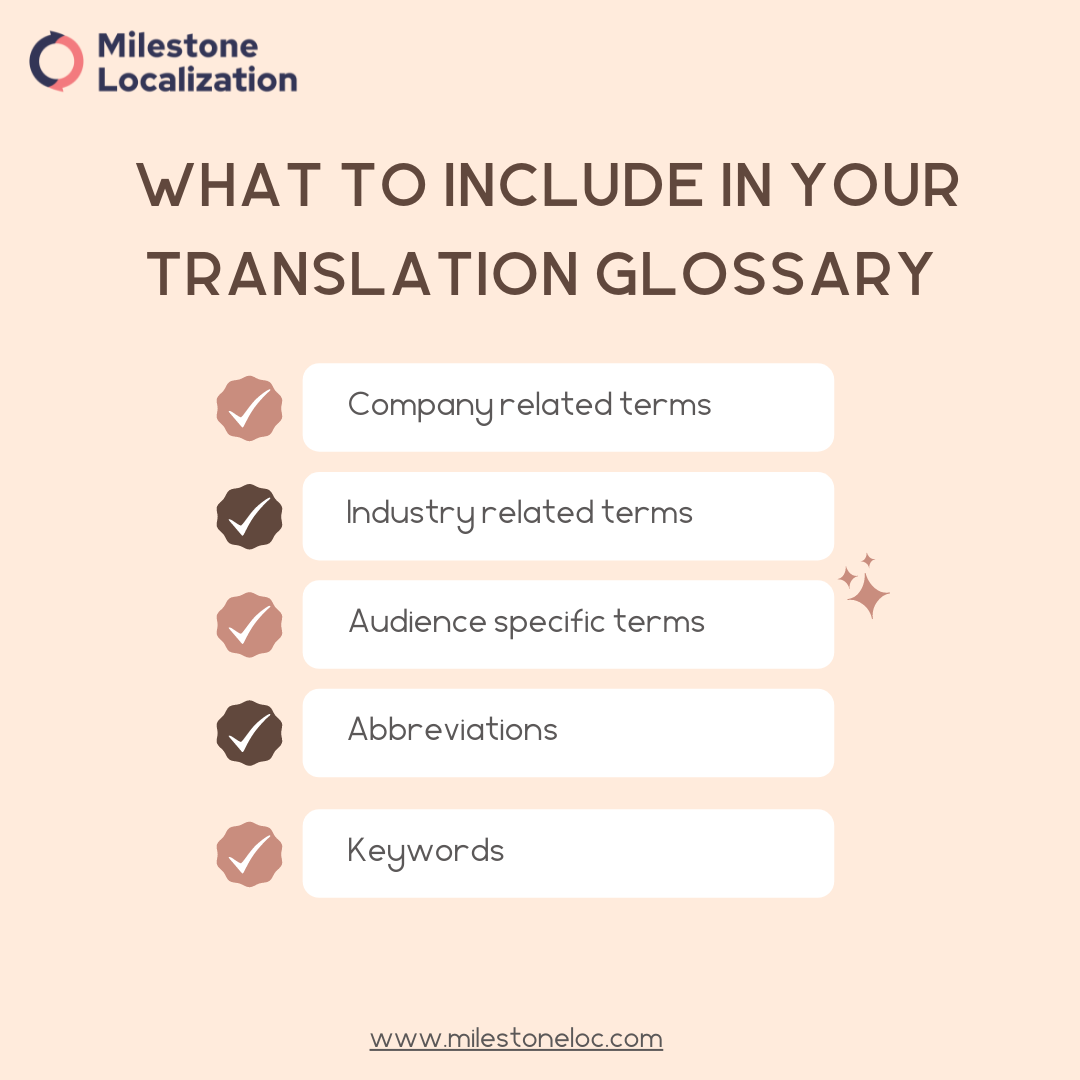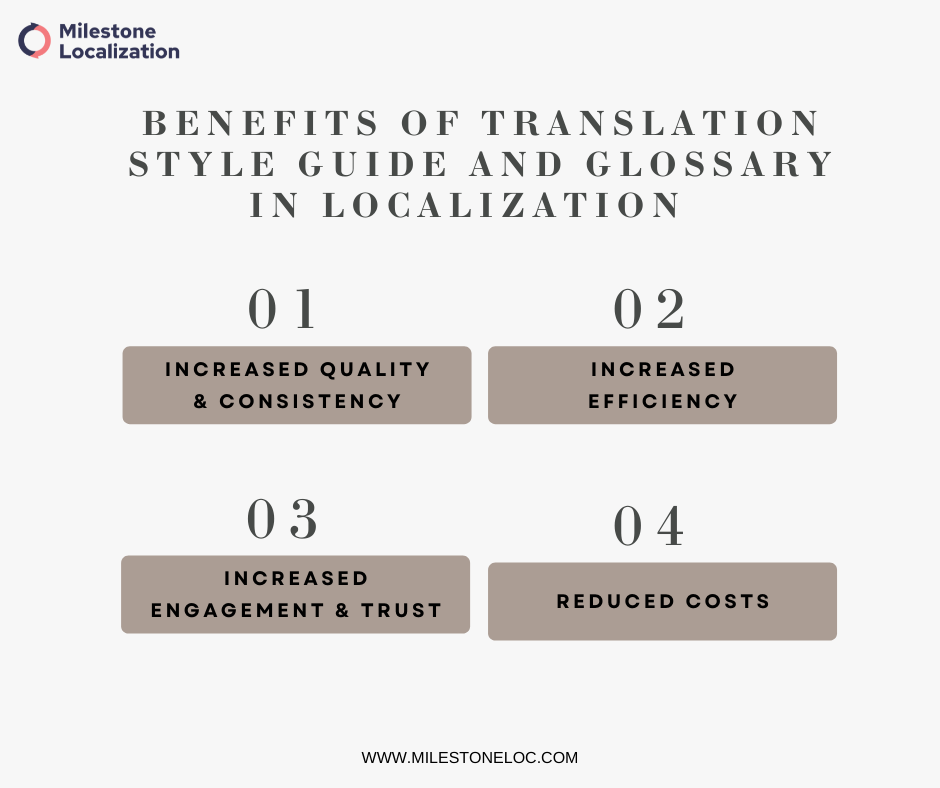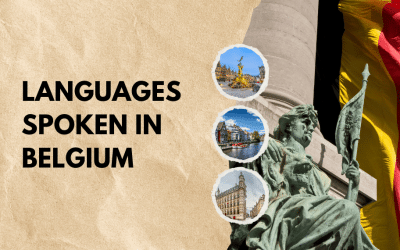A translation glossary, also referred to as a terminology glossary, is a database containing key terms and their approved equivalents in all target languages. The key terms are words and phrases that are frequently used in your brand’s content.
Translation style guides & glossaries form the foundation for successful translation and localization projects. Through such glossaries, one can ensure consistency in terms of terminology across the whole project, regardless of its scope.
This means that translators will be able to use the same, pre-defined terms consistently and correctly in the target language across the entire project.

(A glossary Milestone Localization created for a client)
A translation glossary becomes especially important in big projects with multiple languages. The glossary, along with a style guide is essential to get all stakeholders on the same page and maintain language quality.
Also Read: What is a translation style guide: Free template + examples
Why is a translation glossary critical for SEO strategy?
Nowadays, keywords and SEO are essential for becoming a successful brand on the internet. Indeed, neglecting keywords will make it extremely difficult for your brand to rank in the top position in the local search engines in your target locales.
Having a terminology glossary can be a game-changer in this regard. The right keywords can be picked for your industry and instructions can be given to include them in headings, alt tags and copy.
Make sure you have your glossary before the localization process has begun because it will help translators immensely with issues such as consistency, terminology research, and rework time in building a multilingual SEO strategy
How to create a translation glossary?
Usually, a terminology glossary is created by the LSP (Language Service Provider). The only thing that you have to do is send your source materials so that the LSP can analyze them and set up the glossary.
Of course, the client is always encouraged to participate in the process actively. If you have specific terms in mind that you want to be included in the glossary, you can always share your suggestions with your LSP or the linguists working on the project.
What to include in your translation glossary?
Keep in mind that your glossary should contain terms central to your brand. It shouldn’t be too long, yet it should be comprehensive and inclusive.
Here are some suggestions on what to include:

Company-related terms. You need to make an exhaustive list of copyrighted or trademarked terms as well as names of products, services, or other businesses associated with your brand. You can even include terms that you don’t want to be translated.
Industry-related terms. Sometimes the same term can be related to many fields and industries and thus, have multiple meanings. For instance, “monitor” can mean an act of overseeing, a sentry, or a computer display. Ensure that you include a clear definition of all the terms related to your industry. However, you don’t need to incorporate everything. Terms familiar to your target audience or widely used can be left out.
Audience-specific terms. These terms may include certain slang expressions or other phrases that are commonly used by your audience (e.g., ghosting or foodies). Including audience-specific terms will help linguists recreate your content so that it resonates better with your target audience.
Abbreviations. Abbreviations are among the hardest terminology to translate. Abbreviations are sometimes completely invented, meaning that one could hardly make sense of them.
For instance, if you stumble upon the abbreviation CPS, you have to do your research to find out that it stands for “Child Protective Services.”However, deconstructing the abbreviation to decipher it is not an easy job. When dealing with a completely unfamiliar abbreviation, this research phase can take hours until any progress is made.
So, having a terminology glossary is a game-changer in this regard. You can include all abbreviations that are associated with your company and additional explanations. Sometimes abbreviations don’t have to be translated – take for instance NASA. Still, you have to ensure that all information can be found in the terminology database.
This way, linguists would simply have to search through the database instead of spending hours looking for a single word.
Keywords. Do not miss this one out! Many companies overlook this aspect, which inevitably affects their online presence. Including keywords means that they will be used in your localized content. This way, your content will include the most commonly searched terms in each local market when localized. This, in turn, will be highly beneficial to your overall ranking in the local searches. Thus, make sure that you have included all the keywords that you want to win on in each target language and market.
Other data. You can also include metadata, such as the definition, part of speech, context, approval or review dates as well as terms that appear in your technical documentation or user interface.
Overall, you can put all these types of terms into three categories, having in mind how you want linguists to handle them:
- DNT terms (which stems from “do not translate terms”) such as abbreviations, brand names, product names, etc. For instance, the name of the digital currency Bitcoin is never translated. It is either retained in English or transliterated based on the target language. The same holds for the abbreviation CPU, meaning “central processing unit.”
- Transliterate terms that can be product names, slang, new words, etc. Transliteration is a process whereby a word in one script is transformed into another script while trying to keep the original pronunciation of the word.
For example, the Jewish winter holiday is called חנוכה in Hebrew, which is then transliterated in English as Hanukkah or Chanukah.
- Translate terms – Most terms in a terminology glossary fall into this category. These are terms that have an equivalent in the target language.
Make sure that every term in your terminology glossary is assigned to one of these categories. Otherwise, you will have to deal with a lot of confusion and errors.
Also Read: Back translation – what it is & why it is important
Free Translation Style Guide Template
Use this style guide template to create your
own style guide for an effective localization process.
Best practices for creating & using a translation glossary:
- Start compiling materials for your glossary – If you have old glossaries or translated materials, you can use them as well.
- Then you send the materials to the LSP with the content that needs to be localized/ translated.
- The LSP analyses the materials and extracts all the relevant terms based on the content to be translated.
- A list of all source terms candidates is created and sent to the client.
- Once the client has approved the list, the LSP researches and translates the terms into the desired target language(s).
- Again, the client has to review and approve the translated terms.
Finally, the LSP creates a final version of the terminology glossary and inserts it into the translation technology that the linguists are going to use for the localization project.
Also Read: Best practices for building a multilingual website
Why a translation style guide and glossary are essential for localization?
Both a translation style guide and glossary are great tools for better translation quality and a more efficient localization process.

However, while increased quality is one of the biggest benefits, there are certainly some other assets that you have to keep in mind:
- Increased Quality & Consistency:
Most importantly, these tools enable a consistent message across all markets, regardless of language. For instance, if you don’t want a product name translated, you have to make sure that this is included in your style guide so that everybody working on the project will consistently adhere to this suggestion.
Having consistent brand messaging on a local level will help you establish your brand on a global scale.
Translation style guides and glossaries help linguists successfully localize, and if needed transcreate, your brand’s message and overall content, making it relevant to any language and culture on the global market.
- Increased efficiency:
A global market is a dynamic place, so being able to deliver quality work fast can give you a competitive edge. Style guides and glossaries can significantly reduce the time spent discussing details such as suitable terminology, voice, tone of the message, etc.This, in turn, means that linguists would be able to deliver the localized content faster: no long meetings, back-and-forth emails, stress, and confusion – the localization teams would have access to the provided style guides and glossaries at any time. Whenever they have a question, they simply have to look at the available resources instead of searching for contacts and people to help them. - Increased Engagement & Trust:
Indeed, having a high-quality, consistent brand message across different markets will inevitably attract new customers. A brand’s consistent message and services are essential for building trust in your customers.
Having high-quality translated content will help you not only build your brand’s reputation but also improve customers’ engagement. In fact, customers prefer content in their native language, and many point out access to information in their native language as more important than the price and quality of the product or service itself.
Thus, being able to provide content in the local language of your target market is the best way to establish your brand and attract new customers. - Reduced Costs Style guides and glossaries can significantly reduce the costs of the localization process due to the more efficient workflow. By providing standard, authoritative resources for your LSP, there is less confusion among linguists on what to do and how to do it. Thus, there will rarely be a need for reworking the end translations.
In conclusion
A translation style guide and translation glossaries are essential to localization. These tools can help you achieve high-quality translation while reducing the overall costs and rework time.
Thus, investing in translation style guides and translation glossaries for your next localization project is a crucial element for the success of your localization project.
If you are looking to prepare a Translation style guide & glossary for your business or make changes to your existing ones, We’re here to help.
Milestone Localization is the leading Translation and Localization Agency In India & UK. Get in touch.




